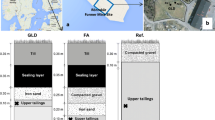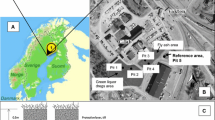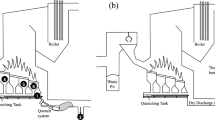Abstract
Different alkaline residue materials (fly ash, green liquor dregs, and lime mud) generated from the pulp and paper industry as sealing materials were evaluated to cover aged mine waste tailings (<1 % sulfur content, primarily pyrite). The mobility of four selected trace elements (Cr, Cu, Zn, and As) was compared based on batch and column leaching studies to assess the effectiveness of these alkaline materials as sealing agents. Based on the leaching results, Cr, Cu, and Zn were immobilized by the alkaline amendments. In the amended tailings in the batch system only As dramatically exceeded the limit values at L/S 10 L/kg. The leaching results showed similar patterns to the batch results, though leached Cr, Cu, and Zn showed higher levels in the column tests than in the batch tests. However, when the columns were compared with the batches, the trend for Cu was opposite for the unamended tailings. By contrast, both batch and column results showed that the amendment caused mobilization of As compared with the unamended tailings in the ash-amended tailings. The amount of As released was greatest in the ash column and decreased from the dregs to the lime columns. The leaching of As at high levels can be a potential problem whenever alkaline materials (especially for fly ash) are used as sealing materials over tailings. The column test was considered by the authors to be a more informative method in remediation of the aged tailings with low sulfur content, since it mimics better actual situation in a field.



Similar content being viewed by others
References
Al-Abed SR, Jegadeesan G, Purandare J, Allen D (2007) Arsenic release from iron rich mineral processing waste: influence of pH and redox potential. Chemosphere 66:775–782
Alakangas L, Maurice C, Macsik J, Nyström E, Sandström N (2014) Kartläggning av restprodukter för efterbehandling och inhibering av gruvavfall: funktion tillgång och logistik. Luleå University of Technology. Rapport. Pp86. In Swedish. https://pure.ltu.se/portal/da/publications/kartlaggning-av-restprodukter-foer-efterbehandling-och-inhibering-av-gruvavfall(b78d91cf-a10d-4643-8e64-6ad24e133129).html (Accessed 2015 − 05 − 11)
Amasa SK (1975) Arsenic pollution at Obuasi goldmine, town and surrounding countryside. Environ Health Perspect 12:131–135
Anawar HM, Freitas MC, Canha N, Regina IS (2011) Arsenic, antimony, and other trace element contamination in a mine tailings affected area and uptake by tolerant plant species. Environ Geochem Health 33:353–362
Arm M, Lindeberg J, Helgesson H (2007) Sammanställning av material och användningsområden. Underlag i Naturvårdsverkets regeringsuppdrag “Återvinning av avfall i anläggningsarbeten” (In Swedish). http://www.swedgeo.se/upload/publikationer/Varia/pdf/SGI-V572.pdf. Accessed 28 Aug 2015
Armienta MA, Rodriguez R, Aguayo A, Ceniceros N, Villasenor G, Cruz O (1997) Arsenic contamination of groundwater at Zimapan, Mexico. Hydrogeol J 5:39–46
Azcue JM, Murdoch A, Rosa F, Hall GEM (1994) Effects of abandoned gold mine tailings on the arsenic concentrations in water and sediments of Jack of Clubs Lake, BC. Environ Technol 15:669–678
Balasoiu CF, Zagury GJ, Deschênes L (2001) Partitioning and speciation of chromium, copper, and arsenic in CCA-contaminated soils: influence of soil composition. Sci Total Environ 280(1–3):239–255
Basu A, Saha D, Saha R (2014) A review on sources, toxicity and remediation technologies for removing arsenic from drinking water. Res Chem Intermed 40:447–485
Bellaloui A, Chtaini A, Ballivy G, Narasiah S (1999) Laboratory investigation of the control of acid mine drainage using alkaline paper mill waste. Water Air Soil Pollut 111:57–73
Benzaazoua M, Bussiere B, Dagenais AM, Archambault M (2004) Kinetic test comparison and interpretation for prediction of the Joutel tailings acid generation potential. Environ Geol 46(8):1086–1101
Bouzahzah H, Benzaazoua M, Bussiere B, Plante B (2014) Prediction of acid mine drainage: importance of mineralogy and the test protocols for static and kinetic tests. Mine Water Environ 33:54–65
Catalan LJJ, Yin GH (2003) Comparison of calcite to quicklime for amending partially oxidized sulfidic mine tailings before flooding. Environ Sci Technol 37:1408–1413
Coulton R, Bullen C, Dolan J, Hallet C, Wright J, Marsden C (2003) Wheal Jane mine water active treatment plant-design, construction and operation. Land Contam Reclam 11:245–252
Del Razo LM, Arellano MA, Cebrián ME (1990) The oxidation states of arsenic in well-water from a chronic arsenicism area of northern Mexico. Environ Pollut 64:143–153
Demers I, Bussiere B, Mbonimpa M, Benzaazoua M (2009) Oxygen diffusion and consumption in low-sulphide tailings covers. Can Geotech J 46:454–469
Dold B (2003) Basic concepts of environmental geochemistry of sulfide mine-waste. In: Geochemistry and geomicrobiology of mine water formation, 27–29 June, Lisbon, Portugal, pp 1−36 Université de Genève. http://www.researchgate.net/publication/228885471_Basic_concepts_of_environmental_geochemistry_of_sulfide_minewaste. Accessed 28 Aug 2015
Dold B, Diaby N, Spangenberg JE (2011) Remediation of a Marine Shore Tailings Deposit and the Importance of Water - Rock Interaction on Element Cycling in the Coastal Aquifer. Environ Sci Technol 45: 4876–4883
Duker AA, Carranza EJM, Hale M (2005) Arsenic geochemistry and health. Review article. Environ Int 31:631–641
Engfeldt C (2006) Aska från energiproduktion producerad och använd mängd aska i Sveige. Svenska EngergiAskor. (In Swedish). www.energiaskor.se
European Council Decision (2013) Council decision of 19 December 2002 establishing criteria and procedures for the acceptance of waste at landfills pursuant to Article 16 of and Annex II to Directive 1999/31/EC. Off J Eur Commun L11:27–49
Fällman AM (1998) Miljömässig karakterisering av järnsand SIG-rapport 2-9709-482, 581 93 Linköping (In Swedish)
Gazea B, Adam K, Kontopoulos A (1996) A review of passive systems for the treatment of acid mine drainage. Miner Eng 9:23–42
González A, Navia R, Moreno N (2009) Fly ashes from coal and petroleum coke combustion: current and innovative potential applications. Waste Manag Res 27:976–987
Grafe M, Eick MJ, Grossl PR, Saunders AM (2002) Adsorption of arsenate and arsenite on ferrihydrite in the presence and absence of dissolved organic carbon. J Environ Qual 31(4):1115–1123
Gray NF (1997) Environmental impact and remediation of acid mine drainage: a management problem. Environ Geol 30:62–71
Hamberg R, Maurice C (2013) Karaktärisering av grönlutsslam för efterbehandling av gruvavfall. Tillgänglig Processum. Intern rapport. Luleå tekniska universitet (In Swedish). http://www.svemin.se/MediaBinaryLoader.axd? MediaArchive_FileID=61449859-1ade-40e8-a9a8-0ddd3c408759&FileName=2_Maurice.pdf. Accessed 28 Aug 2015
Hashim MA, Mukhopadhyay S, Sahu JN, Sengupta B (2011) Remediation technologies for heavy metal contaminated groundwater. Review. J Environ Manag 92:2355–2388
Herrmann I, Svensson M, Ecke H, Kumpiene J, Maurice C, Andreas L, Lagerkvist A (2009) Hydraulic conductivity of fly ash–sewage sludge mixes for use in landfill cover liners. Water Res 43:3541–3547
Höglund LO, Herbert Jr R (eds) (2004) MiMi—performance assessment main report. MiMi 2003:3. The MISTRA-programme MiMi, Mitigation of the environmental impact from mining waste, MiMi Print, Lulea, p 345
Hunt LE, Howard AG (1994) Arsenic speciation and distribution in the Carnon estuary following the acute discharge of contaminated water from a disused mine. Mar Pollut Bull 28:33–38
Jia Y, Stenman D, Mäkitalo M, Maurice C, Öhlander B (2013) Use of amended tailings as mine waste cover. Waste Biomass Valor 4:709–718
Jia Y, Maurice C, Öhlander B (2014) Effect of the alkaline industrial residues fly ash, green liquor dregs, and lime mud on mine tailings oxidation when used as covering material. Environ Earth Sci 72:319–334
Jia Y, Maurice C, Öhlander B (2015) Metal mobilization in tailings covered with alkaline residue products: results from a modified column leaching test using fly ash, green liquor dregs and lime mud. Mine Water Environ 34:270-287
Johnson DB, Hallberg KB (2005) Acid mine drainage remediation options: a review. Sci Total Environ 338:3–14
Kalin M, Fyson A, Wheeler WN (2006) The chemistry of conventional and alternative treatment systems for the neutralization of acid mine drainage. Sci Total Environ 366:395–408
Kalmykova Y, Perez-Holmbeg J, Abbas Z, Steenari BM (2010) Utilization of paper industry waste in contaminated water treatment. In Haz Was Management 2010: B5.5. p 1–8. Oct 2010.http://www.srcosmos.gr/srcosmos/showpub.aspx?aa=14241 (Accessed 2015 − 05 − 11)
Kumpiene J, Lagerkvist A, Maurice C (2008) Stabilization of As, Cr, Cu, Pb and Zn in soil using amendments—a review. Waste Manag 28:215–225
Lapakko K (2002) Metal mine rock and waste characterization tools: an overview, International Institute for Environment and Development. MMSD 67. http://pubs.iied.org/pdfs/G00559.pdf. Accessed 28 Aug 2015
Lindgren M (2005) Efterbehandling av anrikningssanden på Rönnskär, plan för provytya. Project report. Boliden Mineral AB. Skellefteå, Sweden (In Swedish)
Lottermoser BG (2010) Mine wastes: characterization, treatment, and environmental impacts, 3rd edn. Springer, Berlin
Mäkitalo M (2012) Green liquor dregs as sealing layer material to cover sulphidic mine waste deposits. Licentiate Thesis, Luleå University of Technology
Mäkitalo M, Maurice C, Jia Y, Björn Öhlander (2014) Characterization of green liquor dregs, potentially useful for prevention of the formation of acid rock drainage. Minerals 4:330–344
Marmolejo-Rodríguez AJ, Sánchez-Martínez MA, Romero-Guadarrama JA, Sánchez-González A, Magallanes-Ordóñez VR (2011) Migration of As, Hg, Pb, and Zn in arroyo sediments from a semiarid coastal system influenced by the abandoned gold mining district at El Triunfo, Baja California Sur, Mexico. J Environ Monit 13:2182–2189
Masscheleyn PH, Dlaune RD, Patrick WH Jr (1991) Effect of redox potential and pH on arsenic speciation and solubility in a contaminated soil. Environ Sci Technol 25:1414–1419
Maurice C, Villain L, Hargelius K (2009) Green liquor dregs for the remediation of abandoned mine tailings: opportunities and limitations. Proceeding in 8th International Conference on Acid Rock Drainage (ICARD) and Securing the Future: Mining, Metals & the Environment in a Sustainable Society. Curran, Red Hook, 6 pp
Maurice C, Mäkitalo M, Villain L, Öhlander B (2010) Green liquor dregs for the amendment of tailings. In: Fourie AB, Jewell R (eds) Paste 2010. Proceeding of 13th International Seminar on Paste and Thickened Tailings, 487−494. Australian Centre for Geomechanics, Toronto
Mbonimpa M, Aubertin M, Aachib M, Bussière B (2003) Diffusion and consumption of oxygen in unsaturated cover materials. Can Geotech J 40(5):916–932
Monte MC, Fuente E, Blanco A, Negro C (2009) Waste management from pulp and paper production in the European Union. Waste Manag 29:293–308
Mukherjee K, Saha R, Ghosh A, Saha B (2013) Chromium removal technologies. Res Chem Intermed 39:2267–2286
Mukherjee K, Nandi R, Saha D, Saha B (2015) Surfactant assisted bioremediation of hexavalent chromium from contaminated water. Desalin Water Treat 53:746–751
Nason P, Alakangas L, Öhlander B (2013) Using sewage sludge as a sealing layer to remediate sulphidic mine tailings. A pilot-scale experiment, Northern Sweden. Environ Earth Sci 70:3093–3105
Öhlander B, Chatwin T, Alakangas L (2012) Management of sulfide-bearing waste: a challenge for the mining industry. Minerals 2:1–10
Pauwels H, Pettenati M, Greffié C (2010) The combined effect of abandoned mines and agriculture on groundwater chemistry. J Contam Hydrol 15:64–78
Pérez-López R, Nieto JM, de Almodόvar GR (2007) Immobilization of toxic elements in mine residues derived from mining activities in the Iberian Pyrite Belt. Appl Geochem 22:1919–1935
Pérez-López R, Quispe D, Castillo J, Nieto JM (2011) Acid neutralization by dissolution of alkaline paper mill wastes and implications for treatment of sulfide-mine drainage. Am Mineral 96:781–791
Peters CS (1998) Investigative and management techniques for cement kiln dust and pulp and paper process wastes. Environ Prog Sustain Energy 17:142–147
Powell EK, Searcy AW (1982) Surface areas and morphologies of CaO produced by decomposition of large CaCO3 crystals in vacuum. J Am Ceram Soc 65:C42–C44
Price WA (1997) Draft guidelines and recommended methods for the prediction of metal leaching and acid rock drainage at minesites in British Columbia. British Columbia Ministry of Employment and Investment, Energy and Minerals Division, Smithers BC
Ragnvaldsson D, Bergknut M, Lewis J, Drotz S, Lundkvist A, Abrahamsson K, Fernerud S (2014) A novel method for reducing acid mine drainage using green liquor dregs. Environ Chem Lett 12:443–447
Saha B, Orvig C (2010) Biosorbents for hexavalent chromium elimination from industrial and municipal effluents. Coord Chem Rev 254:2959–2972
Saha R, Nandi R, Saha J (2011) Sources and toxicity of hexavalent chromium. J Coord Chem 64:1782–1806
Sapsford DJ, Bowell RJ, Day M, Williams KP (2009) Humidity cell tests for the prediction of acid rock drainage. Miner Eng 22:25–36
Smedley PL, Kinniburgh DG (2002) A review of the source, behaviour and distribution of arsenic in natural waters. Appl Geochem 17:517–568
SS-EN12457-4 (2003) Characterisation of waste–leaching–compliance test for leaching of granular waste materials and sludges, part 4: one stage batch test at a liquid to solid ratio of 10 L/kg for materials with particle size below 10 mm (without or with size reduction). Swedish Standards Institute, SIS/TK 535. STD 33476:1–28
Stahre N (2012) Grönlutslam och flygaska som tätskiktsmaterial för sluttäckning av sulfidhaltig anrikningssand – Utvärdering efter 5 års användning. MSc thesis, Luleå University of Technology, Sweden. (In Swedish with abstract in English). http://pure.ltu.se/portal/files/40148687/LTU-EX-2012-40039243.pdf (Accessed 2015 − 05 − 11)
Statistics-Sweden: Published in collaboration with the Swedish Environmental Protection Agency (2008). http://www.scb.se
Williams M, Fordyce F, Paijitprapapon A, Charoenchaisri P (1996) Arsenic contamination in surface drainage and groundwater in part of the southeastern Asian tin belt, Nakhon Si Thammarat Province, Southern Thailand. Environ Geol 27:16–33
Acknowledgments
The authors wish to thank the Swedish Research Council for the Environment, Agricultural Sciences and Spatial Planning (FORMAS ID 2011-268-19774-35); the European Union Structural Funds; the Northern Sweden Soil Remediation Centre, EDF Objective 2, Contract MCN IO No 43173; the Sveriges Ingenjör Environmental Fund; and the Centre of Advanced Mining and Metallurgy (CAMM) for the financial support.
Author information
Authors and Affiliations
Corresponding author
Additional information
Responsible editor: Philippe Garrigues
Rights and permissions
About this article
Cite this article
Jia, Y., Maurice, C. & Öhlander, B. Mobility of as, Cu, Cr, and Zn from tailings covered with sealing materials using alkaline industrial residues: a comparison between two leaching methods. Environ Sci Pollut Res 23, 648–660 (2016). https://doi.org/10.1007/s11356-015-5300-2
Received:
Accepted:
Published:
Issue Date:
DOI: https://doi.org/10.1007/s11356-015-5300-2




